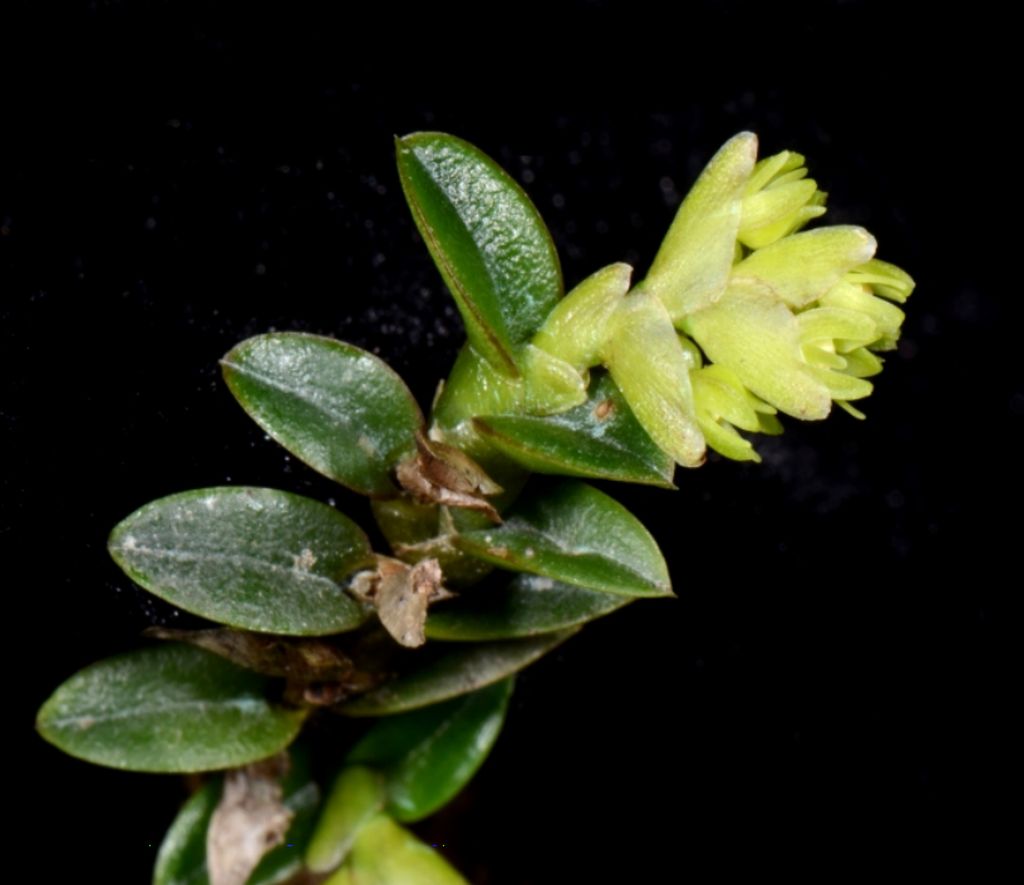

Epidendrum strobiloides Garay & Dunst. 1966 GROUP Ramosum SUBGROUP Flexicaule
Photo/Drawing by © R Jimenez and AMO Herbario Website
Drawing by © Dunsterville & Garay and The Swiss Orchid Foundation at the Jany Renz Herbaria Website




Common Name The Strobile-Like Epidendrum [refers to its similarity to E strobiliferum]
Flower Size .08" [2 mm]
Found in Surinam, French Guiana, Guyana, Venezuela and Ecuador in rainforests at elevations around 100 to 1400 meters as a mini-miniature sized, hot to cool growing epiphyte with short, much branching from the base of the previous stem, basally terete, apically compressed, fractiflex, cane-like stems with new branches arising from the base of the dying inflorescence with 2 to 8 per stem, 7-8 on primary stem, 2-5 on the successive branches, speading, linear-lanceolate, ovate-elliptic when spread, all along the stem, articulate, carinate, deciduous, succulent, distichous, asymmetric, acute, mucronate, margin entire, surface minutely rugose leaves that blooms in the summer on a terminal, without a spathe, arising on the main stem and the branches, occuring only once, racemose, distichous, peduncle .04 to .08" [1 to 2 mm] long, short, .08 to .4" [0.8 to 1.0 cm] long overall, rachis enveloped mostly by imbricate, very large, nervose bracts, succesively then simultaneously 3 to 4 flowered inflorescence with longer than the ovary, slightly imbricated, oblong-ovate, obtuse, scarious floral bracts and carrying pale green to creamy green flowers apparently without fragrance.
"Epidendrum strobiloides belongs to the GROUP Ramosum Flexicaule which is characterized by the sub-monopodial, branching stems, the spike-like, distichous inflorescence, and the single callus, and the SUBGROUP Flexicaule which has a straggling plant habit, where the main stem is not very evident, and the sepals have a dorsal keel which is generally prominent. The species is recognized by the very small plants, stems short and produced from the apex of the previous stem, sometimes branching, plants very compact, distichous inflorescence with up to 4 pale green to creamy green, small flowers with sepals .72 to 1" [1.8 to 2.5 mm] long, 3- veined, ovary .08 to 1" [2.0 to 2.5 mm] long, ventrally prominently inflated, forming a vesicle, lip narrowly triangular-cordiform, with a single transverse, sinuate callus covering 4 small cavities which are separated by the 3 low veins of the disc, the central vein nearly reaching the apex of the lip. Similar to Epidendrum strobiliferum Rchb.f., widely distributed throughout the neotropics, and forming large plants 8 to 12" [20 to 30 cm] tall, larger flowers with sepals .136 to .172" [3.4 to 4.3 mm] long, ovary .186 to .24" [4.6 to 6.0 mm] long, lip with a “Y” shaped callus, and the column with an apical acute process on each side. Epidendrum cornanthera F.Lehm. & Kraenzl. grows along the Atlantic slope of Panama and the Pacific slope of Colombia and Ecuador, below 650 meters altitude, has larger, pendent plants, larger flowers with sepals .2 to .24" [5 to 6 mm] long, ovary .2 to .28" [5 to 7 mm] long, sepals lanceolate, lip triangular, callus of the lip a plate over two cavities; column with an apical, incurved tooth on each side. Epidendrum luckei Bock is found along the Pacific slope from the Darién in Panama to Ecuador below 550 with plants up to 24" [60 cm] tall, with a main stem, and short branches, larger flowers with epals .2 to .248" [5 to 6.2 mm] long, pale green somewhat suffused with brown, the anther and apex of the column purple, lip triangular, callus 3-dentate, with the mid-tooth somewhat longer, and the anther ending in a pair of elongate, laminar horns." Hagsater etal 2018
Synonyms
References W3 Tropicos, Kew Monocot list , IPNI ; *Venezuelan Orchids Illustrated Vol 4 Dunsterville & Garay 1966 drawing fide; Flora de Venezuela Vol XV Tercera Parte Foldats 1970 drawing fide; Orchids of Venezuela, an Illustrated Field Guide Vol 1 Dunsterville & Garay 1979 drawing fide; Inventaire Taxominique des Plantes de la Guyane Francaise Vol II Les Orchidaceaes Cremers and Hoff 1992; Orchids of Venezuela an Illustrated Field Guide Vol 1 Romero & Carnevali 2000 drawing fide; Flora of the Venezuelan Guayana Vol 7 Steyermark, Berry, Yatskievych and Holst 2003; Orchids of French Guiana Szlachetko, Veyret, etal 2012 drawing ok; Icones Orchidacearum 16[1} Plate 1655 Hagsater & Sanchez 2018 see recognition section; Icones Orchidacearum 16[1} Plate 1660 Hagsater & Sanchez 2018 Drawing/Photo fide;
--------------------------------------------------------------------------------------------------------------------------